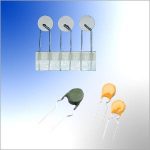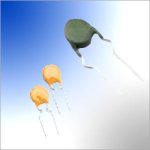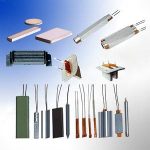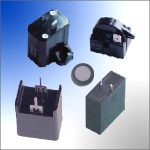PTC Thermistors Application Cautions
PTC Thermistors Storage
Store thermistors only in original packaging. Do not open the package before use.
Storage conditions in original packaging: storage temperature: -25–45C, relative humidity ≦75%.
PTC Thermistors Environmental Conditions
- Environmental conditions must not harm the thermistors.
- Use thermistors only in normal atmospheric conditions.
- Avoid use in deoxidizing gases (chlorine gas, hydrogen sulfide gas, ammonia gas, sulfuric acid gas etc), corrosive agents, humid or salty conditions.
- Contact with any liquids and solvents should be prevented.
PTC Thermistors Handling
- PTC thermistors must not be dropped. Chip-offs must not be caused during handling of PTC thermistors.
- PTC thermistors must not be touched with bare hands. Gloves are recommended.
- Avoid contamination of thermistors surface during handling.
PTC Thermistors Soldering
Use rosin-type flux or non-activated flux.
Insufficient preheating may cause ceramic cracks.
Rapid cooling by dipping in solvent is not recommended.
Complete removal of flux is recommended.
When soldering, care must be taken that the thermistor are not damaged by excessive heat. The following maximum temperature, maximum time spans and minimum distances should be observed:
| Dip soldering | Iron soldering | |
| Bath temperature | max. 260 C | max. 360C |
| Soldering time | max. 10s | max. 2 s |
| Distance from thermistor | min. 6mm | min. 6mm |
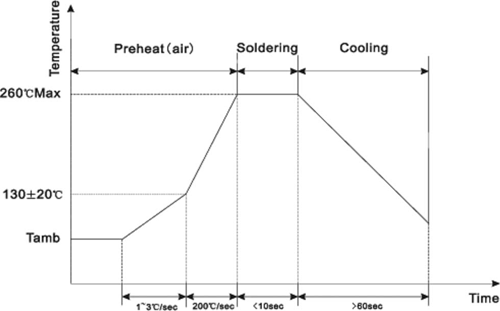
PTC Thermistor Wave Flow Soldering Profile
PTC Thermistors Mounting
- Electrode must not be scratched before during after the mounting process.
Contacts and housing used for assembly with thermistors have to be clean before mounting. Especially grease or oil must be removed. - When PTC thermistor is mounted, there must not be any foreign body between the electrode of the thermistors and the clamping contact.
- During operation, the thermistor’s surface temperature can be very high. Ensure that adjacent components are placed at a sufficient distance from the thermistor to allow for proper cooling at the thermistor.
- Ensure that adjacent materials are designed for operation at temperatures comparable to the surface temperature of thermistor. Be sure that surrounding parts and materials can withstand this temperature.
- Avoid contamination of thermistor surface during processing.
PTC Thermistors Sealing and Potting
- When thermistors are sealed or potted, there must be no mechanical stress through differing thermal expansion in the curing process and during later operation.
- In the curing process the upper category temperature of the thermistor must not be exceeded.
- It is also necessary to ensure that the potting compounds is chemically neutral.
- Sealing and potting compounds may degenerate the titanate ceramic of PTC thermistor and lead to the formation of low-ohmic conduction bridges. In conjunction with a change in dissipation conditions due to the potting compound, local overheating may finally damage the thermistor.
PTC Thermistors Cleaning
- You may use common cleaners based on organic solvents (eg dowanol or alcohol) to clean ceramic and solder joint.
- Solvents may cause plastic encapsulation to swell or detach. So be sure to check the suitability of a solvent before using it.
- Caution is required with ultrasonic cleaning. If the sound power is too high, for example, it can degrade the adhesive strength of the terminal metallization or cause the encapsulation to detach.

